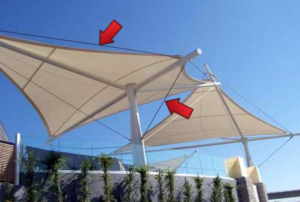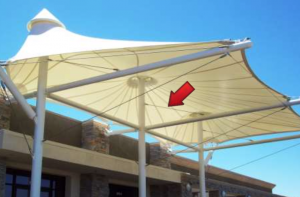Regardless of the shape of your tensioned membrane structure, cables are an important element of tensile architecture. From addressing safety concerns to creating the right aesthetics, these main types of cables all perform important and unique functions for the structure’s design.
Catenary Cables
 Catenary cables run along the perimeter of a fabric membrane inside a pocket or aluminum straps (for longer spans) creating a curve perimeter edge. This helps with the smooth tensioning of the fabric. It provides a natural curved shape but not necessarily a continuous radius, similar to that of a cable hanging freely between two points. The typical catenary curve is 10% of the cable length. A 5% curve would require two times the load to apply the same amount of fabric tension as the 10% curve.
Catenary cables run along the perimeter of a fabric membrane inside a pocket or aluminum straps (for longer spans) creating a curve perimeter edge. This helps with the smooth tensioning of the fabric. It provides a natural curved shape but not necessarily a continuous radius, similar to that of a cable hanging freely between two points. The typical catenary curve is 10% of the cable length. A 5% curve would require two times the load to apply the same amount of fabric tension as the 10% curve.
Guy Cables
 Known in some applications as “stay” cables, guy cables are a tensioned cable that’s designed to add stability to a free-standing structure or compression member. In the photo to the right, the guy cables are between the ends of each compression member to stabilize them from lateral movement. The lower guy cables support the compression members against uplift.
Known in some applications as “stay” cables, guy cables are a tensioned cable that’s designed to add stability to a free-standing structure or compression member. In the photo to the right, the guy cables are between the ends of each compression member to stabilize them from lateral movement. The lower guy cables support the compression members against uplift.
Tie Back Cables
 Technically also a type of “guy” cable, tie back cables are used to support columns in the opposing direction of the fabric tension. They help to reduce the size and cost of the compression columns, and they require additional foundations, more real estate, and traffic control.
Technically also a type of “guy” cable, tie back cables are used to support columns in the opposing direction of the fabric tension. They help to reduce the size and cost of the compression columns, and they require additional foundations, more real estate, and traffic control.
Ridge Cables
 Ridge cables offer supplemental support to the fabric to help with resisting deflections and stress that may be caused by snow loads or long spans. In this specific application, ridge cables may also be known as “radial cables” since they radiate from the center to the membrane corners. Even though these cables are more difficult to see because they follow the fabric, their function is very important.
Ridge cables offer supplemental support to the fabric to help with resisting deflections and stress that may be caused by snow loads or long spans. In this specific application, ridge cables may also be known as “radial cables” since they radiate from the center to the membrane corners. Even though these cables are more difficult to see because they follow the fabric, their function is very important.
Safety Cables
 Safety cables serve two essential functions for tensile architecture. The cables hold up the compression members prior to the fabric being installed. They also serve as a backup system in the unlikely event of a failure with the fabric. A responsible tensioned fabric structure design will remain standing even without the fabric.
Safety cables serve two essential functions for tensile architecture. The cables hold up the compression members prior to the fabric being installed. They also serve as a backup system in the unlikely event of a failure with the fabric. A responsible tensioned fabric structure design will remain standing even without the fabric.
Valley Cables
 Valley cables provide three-dimensional shape to a membrane by pulling down the middle to form a valley. This is similar to ridge cables, but instead of pulling up, these pull down. Not only can this add to the aesthetics of a design, but it can also increase the stress on the fabric and create a more stable form.
Valley cables provide three-dimensional shape to a membrane by pulling down the middle to form a valley. This is similar to ridge cables, but instead of pulling up, these pull down. Not only can this add to the aesthetics of a design, but it can also increase the stress on the fabric and create a more stable form.
Leader Cables
 Leader cables bridge the gap between the working point of a fabric membrane corner and the structural working point. Sometimes, due to landscaping, design intent, or other existing structures, the tension structure attachment point may be a considerable distance from where the shade is required. Leader cables help to overcome that challenge.
Leader cables bridge the gap between the working point of a fabric membrane corner and the structural working point. Sometimes, due to landscaping, design intent, or other existing structures, the tension structure attachment point may be a considerable distance from where the shade is required. Leader cables help to overcome that challenge.
Is Tensile Architecture Right for Your Next Project?
In the Tension Structures Division of Eide Industries, we specialize in design, engineering, manufacturing, and installation of structurally complex and creatively challenging commercial, government, and prototype design projects. We provide expertise and support for architects, landscape designers, general contractors, and property owners to develop their custom tensile membrane project ideas and construct iconic structures.
Explore the options for your next project. Contact one of our experts today by calling 800-422-6827.
